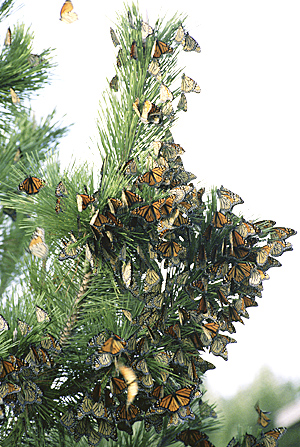Celebrating Monarch Butterflies
 |
| Photo Credit: USFWS
|
Hundreds of national wildlife refuges and a host of programs by the U.S. Fish and Wildlife Service protect and restore monarch butterfly habitat, monitor their transcontinental migration, and teach thousands of school children about their unique migration from Mexico through the United States on to Canada – and then back again. Here are just a few examples of national wildlife refuges in the forefront of conservation and environmental education about the monarch butterfly.
Balcones Canyonlands National Wildlife Refuge, near Austin, Texas – part of the Sister Protected Area Network that runs through the U.S., Canada and Mexico – began in 2000 to tag monarchs as they travel through central Texas from Oklahoma, Minnesota and Missouri. In addition, the refuge reaches children with "Going Buggy," an educational program for those in grades 3-5. In the past year, the refuge has invited school science labs to let monarchs emerge in schools by providing chrysalis from caterpillars attracted to the milkweed planted in flowerbeds around the new refuge headquarters.
Celebrate on October 11: During this year's National Wildlife Refuge Week, people can watch butterflies at their leisure when the refuge sets up its butterfly tent on October 11. Kids and families will be able to look at butterflies – including monarchs – to their hearts' content and learn to distinguish monarchs from other butterflies.
Neal Smith National Wildlife Refuge in Iowa, another refuge in the Sister Protected Area Network, has been working for nearly two decades to recreate – essentially from scratch — more than 5,000 acres of tallgrass prairie and oak savanna, a task never before undertaken in America's Midwest. Tallgrass prairie and oak savanna – composed of bur oak, hickory and walnut trees – were the native plant communities before large numbers of settlers came to Iowa in the 1840s. Nearly 100 percent of the original prairie landscape in Iowa — essential habitat for the monarch – has succumbed to the plow.
The tallgrass prairie restoration began in 1991, when Neal Smith Refuge was established. Today, about 3,000 acres have been restored. Ultimately, the prairie and savanna are expected to cover about 8,600 acres.
Monarch Madness Day: The refuge has been tagging monarch for about three years. On September 13, the refuge will hold its annual Monarch Madness Day, when "children" of all ages get to tag or just learn about the butterfly.
St. Marks National Wildlife Refuge in Florida – also in the Sister Protected Area Network – is holding its 20th annual Monarch Butterfly Festival October 25, when 3,000-4,000 visitors are expected at an extravaganza that fills up hotel rooms more than a month in advance. The University of Georgia will be just one of many exhibitors. The university has been studying a parasite that causes monarch offspring to be born with deformities. Additionally, native plant nurseries will show plants that attract and feed monarchs and other butterflies, while the refuge's photo club will take shots of people in adult-sized monarch costumes – just to make the concept of monarchs personal, indeed.
|





